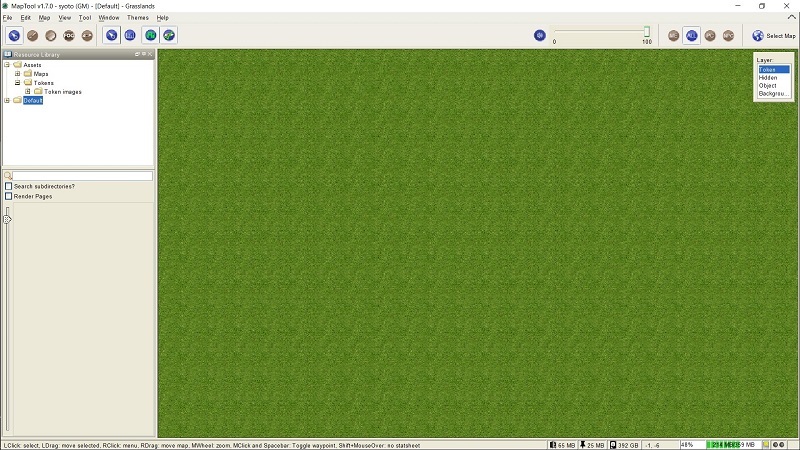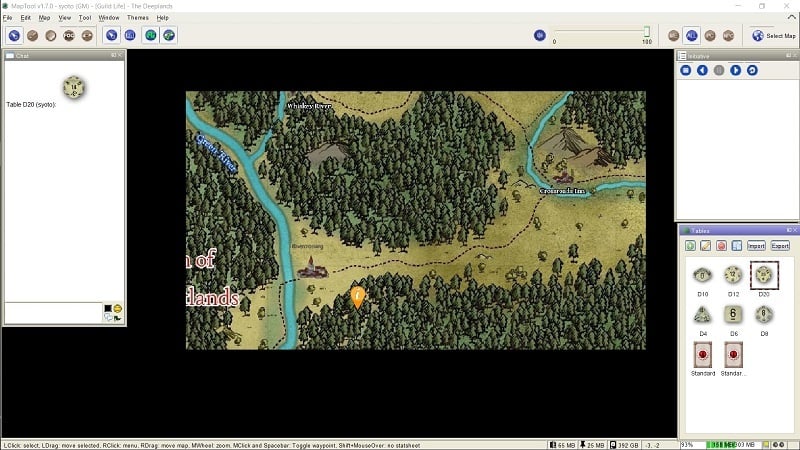So. Pandemic, right? Makes it real hard to do everyone’s favourite group activity. Tabletop Role-Playing Games! (that’s what you guys were thinking, right?)
It was a strange thing, to watch a hit show like Stranger Things have their main characters play Dungeons and Dragons. It’s great to see the wonderful, nerdy things start to come to the forefront of pop culture and relevance. I recently rewatched the series, and it made me think about how tabletop gaming has changed over the years.
And so, I started thinking about how I currently play, using a program called Maptools, a completely free online tabletop platform. No ads, no microtransactions, just you, your computer and the slavering goblin hordes your bard might seduce.
Maptools acts like a digital tabletop, GMs host a server, and players can connect to the server from anywhere with an internet connection. What the GM does, happens on the player’s screen(s), and what the players do shows up on everyone else’s screens. Dice rolling, initiative, text chat, and more can all be done inside the program.
Considering there’s a pandemic roaming around, locking us all in our houses, and that sometimes it’s just hard to collect 4-5 adults in a single physical space for an evening, moving the table to a digital space is now, more than ever, amazingly useful, and safer too!
If you’d like to follow along with this article you can download Maptools here. I use Maptools to play DnD or Pathfinder, and I’ll be discussing how to play those games using Maptools. If you don’t know how to play those games, you probably won’t understand what the hell I’m talking about.
The Basics:
So when you first open Maptools you’ll be greeted with this screen:
If you’re a player you’re about halfway done. Congrats! Go to File, select “connect to server” and find the server your GM started. You can find the server from the list and log in, or you can directly connect to your GM with their IP address. If you’re together physically, you can connect via LAN. Now all you lucky players are pretty much done, you should be in the game, and now you can play! Hurray!
You’ll “arrive” first on either the map you finished on, or the only map available to you. You can move from Map to map using the “select map” button on the top right. From here the basics are pretty simple. You’ll have a token assigned to you, and you can click and drag that token anywhere you can go, and that’s kinda it. From here the game plays exactly like a normal game of DnD or Pathfinder, or whatever. Roll your attacks and checks like normal if you’d like. But there are ways to do everything in the program. Notably though the various windows.
As a player, generally, you’ll only need the initiative, tables, and Chat windows up. Tables give you digital dice, double click on whichever one you need to roll, for attacks, damage, checks, whatever, and it’ll appear in the chat window. (If, when you have the tables window open, the dice don’t appear, go to the “help” drop-down and click “Add default tables”, the dice will reappear when you click back to tables.)
The Initiative window tracks, you guessed it, initiative. Once the encounter starts, players roll, add modifiers, and put in their initiative to their tokens in the window. Then it can be sorted and played through turn by turn. From here, if you know how to play the game, you can use Maptools to play it.
There are tools in the game that can help you measure distances, draw lines to determine LOS.
The GM:
From the GM’s perspective, Maptools give you an extremely powerful and versatile set of tools with which to work. If you’re too distant from your players, it allows you to continue playing from anywhere, even if you’re meeting in person, you can use it if you can connect your laptop to a tv, making that the table. (When I do this, I pass the mouse to whoever’s turn it is).
As a GM, the two most used tools available to you are the most basic, tokens, and maps.
Tokens can act as anything, really. Anything you want to interact with. They can be Players, monsters, NPCs, or information markers. They can be invisible to players, and have anything written on them. Maps can be similarly hidden from players, and don’t have to be actual player maps. They can be used to plot out sessions, and campaigns. Or as token banks, adding tokens and entering in stats ahead of time to seamlessly add and change things on the fly.
That way, if one of my players gets too uppity I can always drop a giant Crocodile on them without having to do a bunch of work during the session.
Inputting a map can be a bit arduous, depending on what kind of game you’re playing. If you’re playing a “classic” style game, where everyone can see the whole board, it’s dead simple. Have a map image, upload it to the game, boom, done.
If you want to make it a little more interesting, you can introduce vision blocking, basically a way to block movement and vision through a particular space that you draw into the map. This can make an individual player’s perspective matter more, and communication can be more important. (If your scout sees a bunch of enemies, only his token sees it, he’ll have to come back and tell the other party members.)
This is the time-consuming part. You have to draw in lines by hand for every wall or obstacle you think would block vision, But personally, I think it’s worth it for the extra immersion.
If you want to try it but you’re feeling daunted, (I definitely was,) there are tonnes of people and loads of resources to look at to learn the program. Thomas Chapman made a great basic tutorial that will help you get far enough to run some basic sessions.
Pros and Cons:
Pros for Maptools:
- It’s Free
- Plays almost any tabletop game
- Connects players online
- It can make sessions really heck’n immersive
- Hugely versatile, and customizable (through coding)
- It’s free
Cons for Maptools:
- It’s complicated (not every player is going to try to learn it.)
- Steep learning curve
- Starting can be work-intensive on the GM
- Can be difficult to adapt official materials. (hope you like converting files.)
- Have to deal with some secondary problems like internet port forwarding and general tech stuff. (which I am full-on shite at)
Conclusion:
If you are at all interested in any tabletop games, or you’ve played one before but you could never find the time or space to get together anymore, or if your games stalled out because of the plague, then you should pick it up. Download Maptools, find a PDF to download, find a module, and get playing!
If you can’t find a module, then make one! If you’re a player mention it to your GM, and try to pick up the program to help them learn it. And if you’re a GM, start by watching Thomas Chapman’s tutorial to see if you think you’ll like it! Then punish your bard for trying to F**k the dragon.
- The Science Behind Cyberpunk 2077: Cybernetics in Fiction vs Real-life - August 13, 2021
- Mass Effect Legendary Edition – What’s Different? - July 3, 2021
- The Shore Review: A Lovecraftian Experience (Spoiler Free) - February 19, 2021





